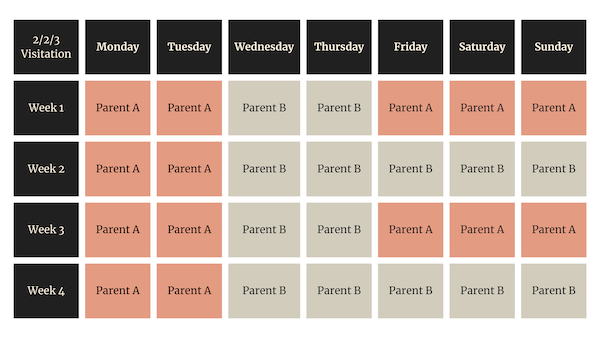Co-parenting After Divorce
The decision is final – you are getting divorced. But what about the kids?
Marriage is a partnership. When that ends, couples often find themselves navigating difficult decisions around how they will handle child custody arrangements once they are no longer married.
Many worry about missing out on the day-to-day moments – the quiet after-school evenings, the chance to get to know friends in carpool, family dinners, and weekend extravaganzas. Being apart means that you’ll be redefining how and when you spend time with your children.
And holidays. What about the holidays?
It may take some time to find your groove, but the right custody arrangement can help everyone involved move forward
Determining the best arrangement to suit your needs and meet the needs of your children will serve your family well, but where should you start? While state laws and personal circumstances mean that each case will be unique, there are several options that many couples consider.
Standard
Standard visitation is a traditional approach that recognizes a primary and secondary parent. Children are with the primary parent most of the time, often spending weekdays and every other weekend together. The secondary parent steps in every other weekend and one dinner or overnight on the opposite week. This arrangement works for many families and has historically been the most used model.
Pros: Standard visitation offers fewer transfers for kids during the school week and is particularly convenient if one parent works a more time-intensive schedule or travels during the week.
Cons: The role of parenting will fall more heavily on one parent than the other. If your parenting style already mirrors this, then it might be a good arrangement for your family. However, if you are a couple that has worked to achieve more of a 50/50 balance in parenting or career, this arrangement will feel very different for everyone involved.
Extended
Extended visitation offers a little more time with the secondary parent. Rather than a Friday to Sunday weekend visit, every other weekend is an extended three-night visit, often starting on Thursday.
Pros: This approach generally offers a consistent home base for kids during the school week and works well when both parents have some flexibility in their schedules.
Cons: While slightly softened, the role of parenting still falls more heavily on one parent than the other with this arrangement.
Weekly
The weekly exchange is another common way to arrange joint custody. It is a week-on, week-off approach where children switch houses every other week that offers a genuine 50/50 split of time between parents. The perk of this arrangement is that parents have equal time with their kids, but, for an active and engaged parent, seven nights is a long time to be away.
Pros: The role of parenting is evenly shared. This arrangement also creates predictable scheduling, which often works well for working parents and older children with busy lifestyles.
Cons: Seven days is a long time to be away from each other. While scheduling may be easier, the constant change may make it harder to maintain routines, like bedtime and family social hours.
2/2/3
The 2/2/3 is a relatively newer approach to joint custody that better aligns with a 50/50 parenting style. With this plan, children stay with each parent two nights per week, and alternate weekends for the remaining three days. The weekly schedule might resemble the following example:

Pros: The role of parenting is more evenly shared. This arrangement offers less time between visits and allows for each parent to have both weekday and extended weekend time on a regular basis. There are also predictable days each week that children will be with each parent, which can help with scheduling activities. Families with younger children often explore this option because of the shortened time between exchanges.
Cons: If one parent has a less predictable work schedule, this arrangement may be difficult to maintain. If parents do not live near each other or communicate about their children’s needs well, frequent exchanges during the week can be challenging. Over time, a commitment to live in the child’s school district may be difficult to maintain, and some compromises may be needed.
Go Your Own Way
There are multiple variations of the standard, extended, weekly, and 2/2/3 custody arrangements. A skilled attorney can help you tailor a plan to fit the needs of your family and align with your state laws.
It may take some time to find your groove, but the right custody arrangement can help everyone involved move forward. Over time, as your children grow and their needs change, don’t be afraid to revisit the plan, especially if you find that things that were once working have since broken down.
Although you may no longer be married, if you are committed to co-parenting you can create a solution that works.
An experienced attorney can help you navigate the options that best fit your family. Connect with a top divorce lawyer in your area today.






















































